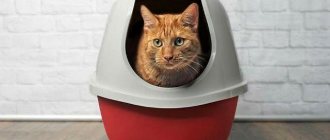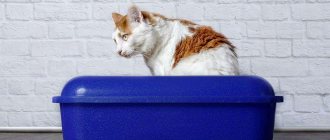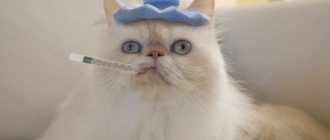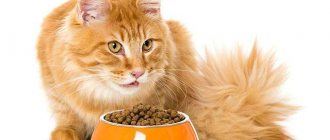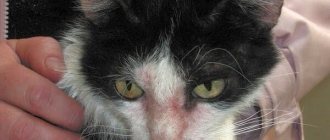The situation when a cat does not go to the toilet for a long time is quite common. There can be many reasons for such a deviation - from the most harmless to the very serious. Owners should remember that a healthy cat defecates approximately once every 1-2 days. In older animals, the period between bowel movements can stretch up to three days, but small kittens usually poop several times a day.
The frequency of trips to the toilet largely depends on the characteristics of the pet’s diet. However, if 3 or more days or even a whole week have passed since the last visit to the tray, you should be wary. Constipation may indicate serious health problems. It is imperative to find out the cause of the deviation and help the cat.
© shutterstock
About the causes of constipation
Prolonged absence of bowel movements is an alarming symptom; the condition can be accompanied by severe pain. Feces accumulated in the gastrointestinal tract can, over time, cause inflammatory processes, intoxication of the body, and in severe cases lead to complete intestinal obstruction. In the latter case, death is possible.
Delayed defecation has a clear gradation in medicine; it is divided into:
- According to the organic mechanism of action.
Feces are retained in the intestines due to physical obstacles in the form of tumors, neoplasms, and scars.
- According to the functional mechanism of action.
The cat stops going to the toilet due to insufficient activity of the gastrointestinal tract. Reasons: sedentary lifestyle, inappropriate food, inflammation, intoxication, metabolic disorders, chronic diseases.
Also, a distinction is made between partial stool retention (feces are excreted in a minimal amount, the bulk is retained in the body), and complete stool retention (feces remain completely in the intestines).
Additional symptoms to watch out for:
- Painful bowel movements - the animal screams during bowel movements and experiences pain when palpating the abdomen. Possible causes: gastroenteritis, diseases of internal organs, mechanical damage to the pelvis.
- intense bowel movements - a small predator often visits the toilet, feces come out in small portions or there is no bowel movement at all. Constipation gives way to diarrhea, stool has a liquid consistency. Possible causes: gastroenterocolitis, enterocolitis.
Problems with bowel movements often occur as an additional symptom to chronic diseases.
- Inflammatory processes in the gastrointestinal tract develop due to irregular nutrition, too cold or hot food, monotonous diet, poisoning, allergic reactions, parasites, infections. The disease is accompanied by constipation, vomiting, loss of appetite, and aggressive behavior of the animal.
- Inflammation of the pancreas (pancreatitis) develops both as an independent disease and in the case of parasitic infection. Signs: lack of bowel movements, loss of appetite, pain, bloating in the abdominal area.
- Increased gas formation is observed in animals due to improper feeding. Flatulence is accompanied by constipation, the stomach swells and becomes hard, the pet experiences pain and screams.
- Gastrointestinal blockage develops due to hairballs trapped in the stomach; bones for food; sedentary lifestyle; foreign objects swallowed by the cat. Signs: feces are not excreted, colic occurs, the pet’s behavior changes, pain and vomiting occur after eating, the stomach is bloated.
- Excess weight (obesity) occurs due to an unbalanced diet, problems with the liver, and endocrine system. The process of defecation occurs rarely, the pet leads a sedentary lifestyle.
- Lack of weight (dystrophy) develops due to a lack of nutrients in feed. The small predator has virtually no defecation, the animal is extremely thin, the fur is dull, and the mucous membranes are bluish in color.
- Helminth infestation. When infected with helminths, a pet loses weight, refuses food or eats excessively, constipation gives way to diarrhea, behavior changes, the stomach increases in size, and itchy sensations appear in the anus.
Be sure to read:
Urinary incontinence in a cat: causes and treatment, symptoms, medication and alternative treatment
Treatment of constipation with various drugs is directly related to the causes of the unpleasant condition.
Why doesn't my little kitten poop?
Kittens that are still under the “wing” of their mother are completely dependent on her in this delicate matter. Babies under one month old can poop normally only after the cat massages their tummy.
If such a baby does not go to the toilet for a long time, it means that the mother is not coping well with her responsibilities. This often happens to young, inexperienced cats “raising” their first litter. Causes of constipation in older kittens may include :
- severe stress due to weaning from mother and moving to a new place of residence;
- a sharp transition to a new type of diet (from milk to solid food);
- unsuitable food;
- congenital intestinal pathologies.
If quite a lot of time has passed since moving to a new home, and the baby still hasn’t gone to the toilet, and adjusting the diet does not help, most likely, the last of the listed points is occurring. The kitten should definitely be shown to a veterinarian. Serious treatment may be required, including surgery.
© shutterstock
How often should a cat go to the toilet?
Defecation rate for cats:
- Adult pet - 1 time per day.
- Kitten - 1-2 times a day, kittens have an increased metabolism, food is digested faster.
- Elderly animal - 1 time in two days; in pets older than 6 years, the metabolism decreases.
According to veterinarians, constipation is considered to be a delay of three or more days. Associated symptoms: anxiety, lack of appetite.
Doctors recommend examining your pet's stool to identify the disease at an early stage. In a healthy cat, feces are oblong in shape, dark brown in color, and soft in consistency.
Deviations:
- overly dry, cracked “balls”,
- liquid consistency,
- unusual color (gray, yellow, red),
- presence of foreign inclusions
Changing your diet
A sudden change from one diet to another can lead to digestive upset in a kitten - this can be expressed either by diarrhea or constipation. Therefore, in the first week after purchase, it is advisable to feed the pet in the same way as the breeder did. Good breeders usually pay a lot of attention to this issue and often give new owners a supply of food for several days. Often, owners try to feed the kitten home-cooked food, but it all ends with the kitten eating only boiled or even raw meat and boiled eggs, and such a diet not only does not meet the nutritional needs of the kitten’s growing body, but also leads to constipation.
First aid for constipation
You can quickly help your cat at home by giving the animal an enema or inserting a rectal suppository into the anus.
Rectal laxatives with glycerin for humans can also be used for cats. Half a candle is placed on the cat. Cut the candle lengthwise, carefully insert it into the anus, hold the pet in your arms, stroking the belly in a circular motion to stimulate peristalsis. Repeat the procedure after 4-5 hours; if there is no bowel movement, administer an enema.
Symptoms
The incubation period ranges from several hours to three days. Some time after infection, the patient begins to feel weak, nauseated, and the temperature rises. Then vomiting begins, it can be either single or multiple. In children, the symptoms are more pronounced and they suffer more severely from the disease. Then abdominal pain begins, which is accompanied by stool disturbances: at first it becomes mushy, then develops into diarrhea. After a few hours, the patient feels dry mouth - this is the first sign of dehydration. The patient loses weight, this is especially pronounced in children under one year old. Dehydration causes dry, cracked lips and sunken eyes. If the patient does not urinate after 6 hours, then this is a dangerous symptom of dehydration. If a child suffers a severe illness, it is best to hospitalize him. In a hospital setting, there are more opportunities to bring the child out of this state: droppers are used to eliminate dehydration.
Treatment at home
In the initial stage, you can get rid of the problem at home.
- Changing your diet.
You need to start feeding the cat fractionally liquid food (5-6 times a day), the portions should be small, you should add a little vegetable oil and bran to the food.
- Feeding with vegetables.
You need to add raw carrots and beets, chopped in a blender, to your daily food. If the cat does not want to eat vegetables, you should squeeze out the vegetable juice through gauze and inject it into the mouth through a syringe without a needle.
- Introduction to the diet of foods that normalize digestion.
Be sure to read:
The cat has dark urine: causes and treatment, what should be normal, what the color change indicates
Fermented milk products with low fat content (kefir, fermented baked milk, yogurt) can normalize the animal’s digestive processes.
- Daily massage.
You can massage your cat's belly daily, stroking it clockwise with force.
Factors causing the problem
Impaired bowel movements can occur if the following factors are present:
- Acute intestinal obstruction. The problem develops if a foreign body (fur, swallowed paper or cellophane) interferes, and intussusception occurs.
- Neoplasms in the colon. This can cause compression of the intestinal lumen and block the passage of stool.
- Inflammatory pathologies in the intestines.
- Problems with the anus. Due to mechanical damage to the sphincter (for example, scar deformation), defecation may be difficult.
- Disturbed diet. Lack of fiber and water, consumption of dry food can provoke excessive dryness of feces, which impairs its excretion.
Laxatives: Top 5
- Medicines based on lactulose (Dufolak, Romfalak, Gudalak). The drugs can be used for a long time, the drugs are suitable for animals, have a gentle effect on intestinal motility, and are safe for health. Bowel movement occurs within 2-3 hours, taken in the morning and evening, single dose - 0.5 mg per kilogram of weight.
- Magnesium sulfate solution. The product acts on receptors in the walls of the gastrointestinal tract, effectiveness is achieved after 7-10 hours. single dose - 2-4 mg.
- "Ramnil" is a medicine made from buckthorn bark. The drug in tablet form is given to the animal once a day. A single dose is half a tablet.
- Carlsbad salt solution. The product helps improve digestion processes and leads to gentle bowel movements. Dilute a tablespoon of powder in 100 ml of water and give to the cat 2 times a day.
- "Izafenin". Taking the powder helps cope with chronic constipation and is used as prescribed by a veterinarian.
Preventive actions
Constipation can occur in cats of any age and breed. The animal owner should try to minimize the risk. You just need to follow these recommendations:
- Brush your cat regularly, especially during intense shedding, to prevent him from swallowing his fur;
- ensure that there is always clean water in the drinking bowl;
- Deworm the animal 3-4 times a year;
- play with the cat, because physical activity helps the intestines work better;
- do not give your pet bones;
- remove small objects from the floor so that the cat does not swallow them;
- Provide your cat with adequate nutrition - it is best to feed it with high-quality industrial formulas.
At the first symptoms of stool retention, it is better to seek veterinary help. There is no need to waste time, because the effectiveness of treatment directly depends on whether it is started on time.


